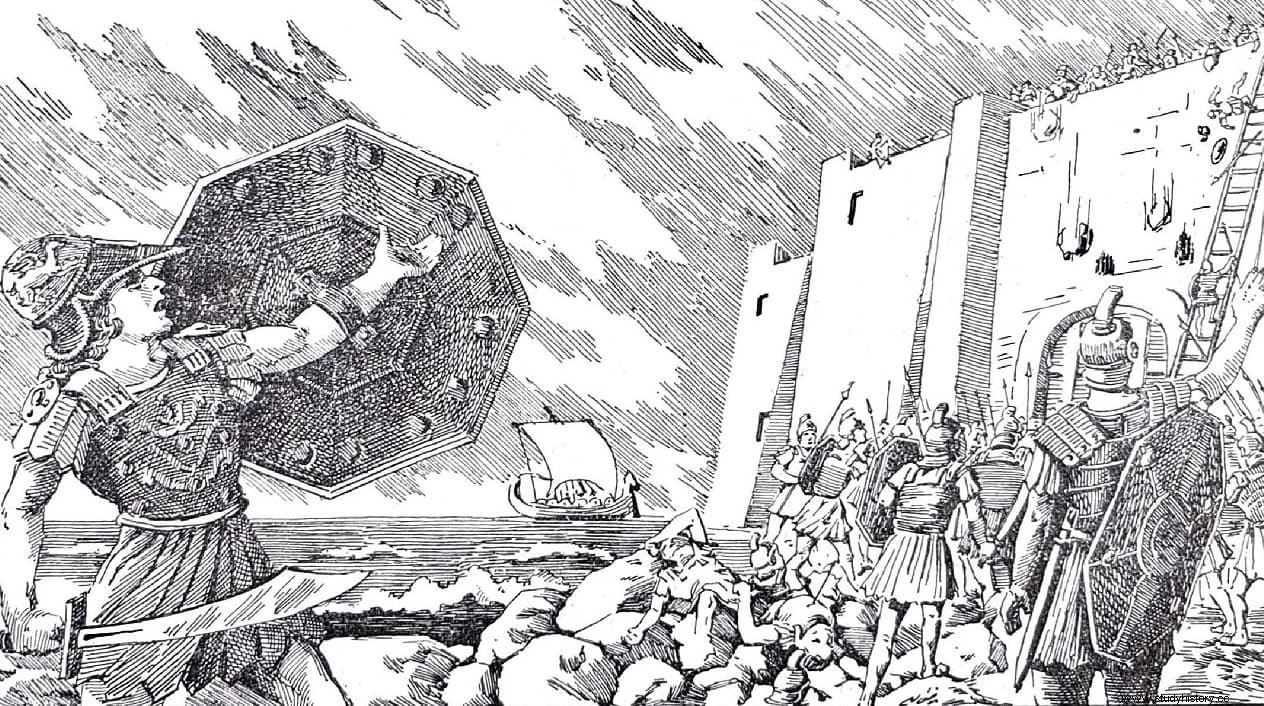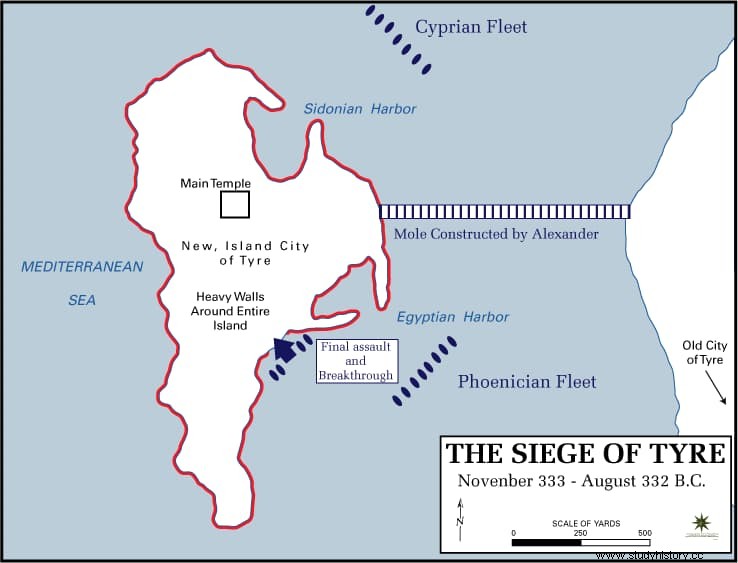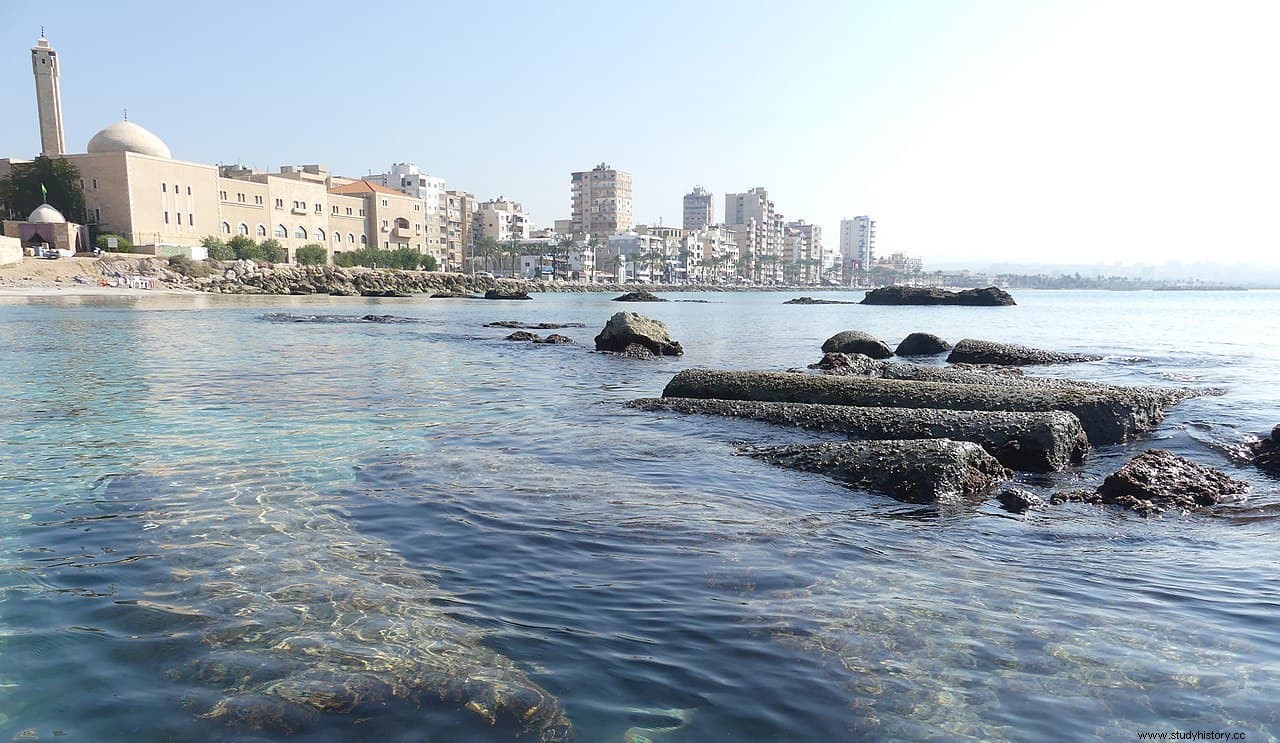The city of Tire in southern Lebanon is one of the oldest cities in the world. Originally founded by settlers from the nearby city of Sidon in the third millennium B.C., Tire became politically independent as Egyptian influence waned in Phoenicia, later surpassing even Sidon to become the most important Phoenician trading center and seaport, with trade ties with all parts of the Mediterranean world.
The city is located on a small peninsula that protrudes from the Lebanese coast almost two kilometers. But it was not always like this. Tire was originally an island with half a kilometer of open water separating it from the mainland. The island was formidably defended with high walls surrounded on all sides that were 45 meters high in parts. The city was considered impregnable, having withstood several sieges in the past, including a 13-year one by the Babylonian king Nebuchadnezzar.

In January 332 B.C. Alexander arrived in Phenicia, having defeated Darius III at the Battle of Issus in November 333 BC. All the Phoenician cities, with the exception of the island of Tyre, surrendered to Alexander's army without a battle.
Alexander was aware of the supposed impregnability of Tyre, and he knew that the city would be difficult to conquer without a naval fleet, which it did not have. But subjugating Tire was important to Alexander, because it was the last Persian port in the region.
He then decided to use trickery to get in. He told the Tyrians that he wanted to make a sacrifice in the ancient temple of the Tyrian god Melqart, whom the Greeks identified with their own god Heracles. But the Tyrians were not fools and refused to admit Alexander, suggesting that the Macedonians make their sacrifice to Heracles in a temple on the mainland. Alexander tried to negotiate, but the Tyrians executed his messengers and threw their bodies into the sea.
Alexander was furious and determined to capture Tyre. He ordered the construction of a great causeway (or wharf), across the narrow channel, using the rubble from demolished buildings on the mainland. The water was shallow, about two meters, and work progressed rapidly. But as they approached the island the water grew deeper and the sea heavier, and the Tyrians constantly harassed the builders by firing missiles from the citadel walls.
Alexander built two 50-meter-high siege towers out of wood and covered them with rawhide to protect himself from enemy fire arrows. Like most of Alexander's siege towers, these were moving artillery platforms, with catapults on top. He positioned the towers at the end of the causeway, and from the top Alexander's army was able to return fire.

The Tyrians responded by building a ship of fire. They took an old ship, loaded it with pitch, sulfur and various other fuels, hung oil cauldrons from the mast and set it on fire. They then ran the burning ship aground on the wharf the Macedonians were building, engulfing the two siege towers in flames. Other Tyrian ships fired on the Macedonian builders, driving away anyone who tried to put out the fires.
The destruction of the siege towers and parts of the causeway was a major setback for Alexander, but the young king was determined to rebuild it. He immediately started with a second, wider pier that could hold more towers, but in the back of his mind he knew that the siege could only succeed if he attacked with a fleet.
So he set out for Sidon to search for ships. He raided the coast capturing Phoenician ships and crews that had previously served with the Persians. Two Phoenician kings, Gerostratos of Arados and Ainel of Byblos, voluntarily joined Alexander, perhaps sensing where the fortunes of war would go. In addition, the kings of Cyprus sent another 120 ships to join him. Soon Alexander had a formidable fleet of over 250 ships.
When Alexander arrived with his fleet the Tyrians blockaded their ports and barricaded themselves inside. With the ships standing guard, Alexander resumed construction of the dock. The Tyrians tried to prevent the fleet from getting too close to the city walls by creating obstacles in the sea with a large number of stones thrown on the city walls. Alexander ordered the rocks to be lifted from the water with ropes so that the path could be cleared. The Tyrians sent divers to cut the anchor ropes of the besieging ships. Alexander responded by replacing the ropes with iron chains.

Eventually the dock was extended into the city allowing Alexander to bring his siege engines and battering rams with which to pound the walls. He found a weak spot in the wall at the southern end where his army managed to open a hole. Once his troops broke through, they easily overcame the garrison, and quickly captured the city.
The Macedonian army slaughtered the population of Tyre, and only those who took refuge in the temple of Melqart were spared. Some 6,000 men were killed in combat and another 2,000 Tyrians were crucified on the beach. The rest of the population, some 30,000 people, mostly civilians, were sold into slavery. Alexander's men suffered few casualties, with only about 400 killed.
The construction of the pier completely changed the geography of the coast. For centuries after the siege it became an obstacle to sea currents, causing sediment to be deposited on both sides of the causeway, and an isthmus began to form. When Tire became part of the Byzantine Empire at the end of the 4th century, the city was no longer an island, but was well connected to the mainland by a wide peninsula.
Today this sandy peninsula is around half a kilometer wide and highly urbanized with hundreds of apartment blocks. Tyre's southern harbor gradually filled with silt and has long since disappeared, but the northern harbor is still in use and filled with fishing boats and pleasure craft.
This article was published on Amusing Planet. Translated with permission
